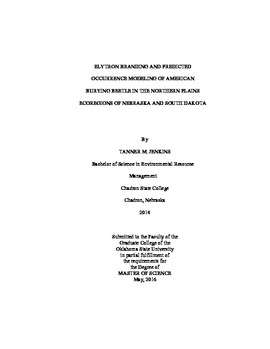| dc.contributor.advisor | Hoback, William W. | |
| dc.contributor.author | Jenkins, Tanner Michael | |
| dc.date.accessioned | 2017-02-22T22:15:17Z | |
| dc.date.available | 2017-02-22T22:15:17Z | |
| dc.date.issued | 2016-07-01 | |
| dc.identifier.uri | https://hdl.handle.net/11244/49091 | |
| dc.description.abstract | The conservation of an endangered species often requires knowledge of not only the causes of the decline, but also the current distribution and habitat requirements of the species. In Nebraska, the American burying beetle, Nicrophorus americanus (Olivier) populations occur in three ecoregions. Previous studies have produced predictive occurrence models based on habitat suitability in the Loess Canyons and Sandhills ecoregions. This study examines occurrence of American burying beetle in the Northwestern Prairie ecoregions of Nebraska and South Dakota. Two methods were used for the construction of predictive occurrence models, a computer learning system (random forest), and generalized linear model (logistic regression). Both models indicated average minimum winter temperature was a strong predictor, and the random forest model found average precipitation and percent coverage of grassland to be positive predictors, while the generalized linear model found percent coverage of wet grasslands to be a strong positive predictor. The random forest model produced an area under the curve 0.82 and the logistic regression model produced an area under the curve of 0.83. Along with predictive occurrence modeling, population estimates are heavily used to monitor the health of known population of American burying beetles. Mark-recapture population estimates require the use of permanent marks that do not alter the survival or behavior of marked individuals. Studies have revealed problems with mark retention or damage to tested individuals associated with permanent marks. Currently used permanent marking techniques involve making a hole or removing a wedge from an ABB elytron. In this study, we tested the efficacy of elytron branding using a surgical cauterizer. The cauterizer was used to ablate one of the orange maculations on the elytron of Nicrophorus beetles. I found that the marking technique was rapid compared with other techniques, permanent, and easily interpreted. | |
| dc.format | application/pdf | |
| dc.language | en_US | |
| dc.rights | Copyright is held by the author who has granted the Oklahoma State University Library the non-exclusive right to share this material in its institutional repository. Contact Digital Library Services at lib-dls@okstate.edu or 405-744-9161 for the permission policy on the use, reproduction or distribution of this material. | |
| dc.title | Sandbur Seed Ecology and Control in Bermudagrass Turf and Pastures | |
| dc.contributor.committeeMember | Mulder, Phillip Jr. G | |
| dc.contributor.committeeMember | Davis, Craig A | |
| osu.filename | Jenkins_okstate_0664M_14593.pdf | |
| osu.accesstype | Open Access | |
| dc.description.department | Entomology & Plant Pathology (MS) | |
| dc.type.genre | Thesis | |
| dc.type.material | text | |
